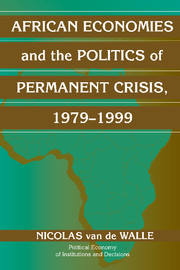Book contents
- Frontmatter
- Contents
- List of Tables
- Acknowledgments
- Introduction
- 1 Approaches to Africa's Permanent Crisis
- 2 Patterns in Reform Implementation, 1979–1999
- 3 Decision Making in Postcolonial Africa
- 4 State Responses to the Permanent Crisis
- 5 The Crisis and Foreign Aid
- 6 Democratization and the Prospects for Change
- 7 Conclusion
- Index
- Title in the Series
2 - Patterns in Reform Implementation, 1979–1999
Published online by Cambridge University Press: 05 June 2012
- Frontmatter
- Contents
- List of Tables
- Acknowledgments
- Introduction
- 1 Approaches to Africa's Permanent Crisis
- 2 Patterns in Reform Implementation, 1979–1999
- 3 Decision Making in Postcolonial Africa
- 4 State Responses to the Permanent Crisis
- 5 The Crisis and Foreign Aid
- 6 Democratization and the Prospects for Change
- 7 Conclusion
- Index
- Title in the Series
Summary
The Zambian government first committed itself to civil service retrenchment in 1979, in response to growing fiscal deficits and donor pressures. Fairly reliable government statistics from the Monthly Digest of Statistics indicate there were 129,600 public employees that year, in addition to 136,220 parastatal employees. The government's stated commitment to eliminate up to half of the civil service was praised by the World Bank and heavily criticized by the ZCTU, the Zambian Trade Union Federation. A reform package was not put in place until 1986 and it resulted in minor staff removals, through a lowering of the retirement age. In May 1988, a cabinet office task force on restructuring the public service submitted a new action plan calling for a 25 percent reduction in the civil service. The plan was not implemented, but in August 1990 the government contracted a local consulting firm to develop another ambitious retrenchment exercise, under the donor-financed Public Service and Retrenchment Project. Reform efforts continued throughout the 1990s, though to little effect. In November 1993, the government launched the Public Service Reform Program, vowing to cut the civil service by 25 percent within three years, again with support from the donors. The United Nations Development Program (UNDP) financed a team of experts to oversee a plan for retrenchment, reorganization, and upgrading of the civil service. Critics of the government actually blamed civil service retrenchments for the rise in unemployment.
- Type
- Chapter
- Information
- Publisher: Cambridge University PressPrint publication year: 2001



